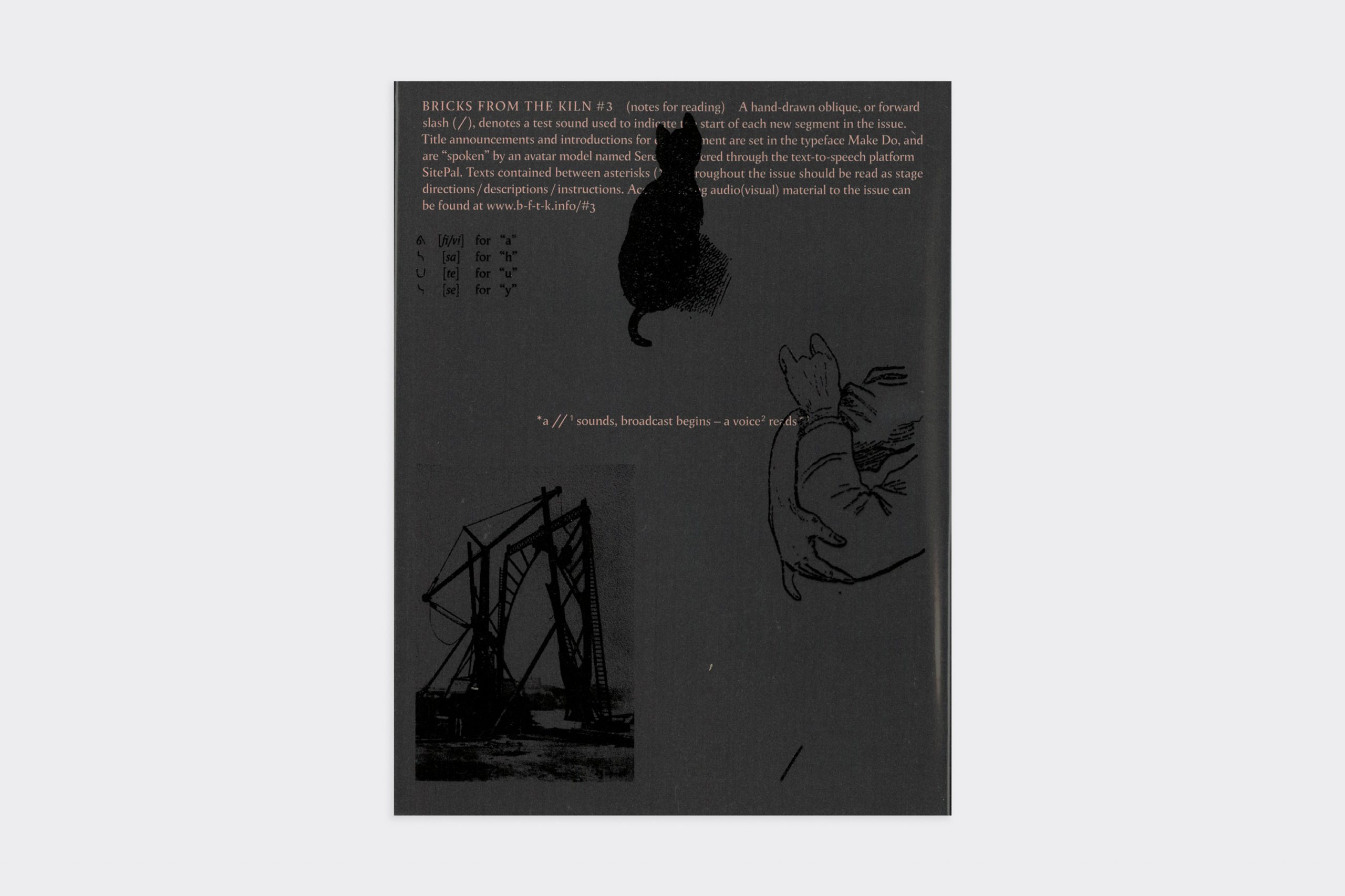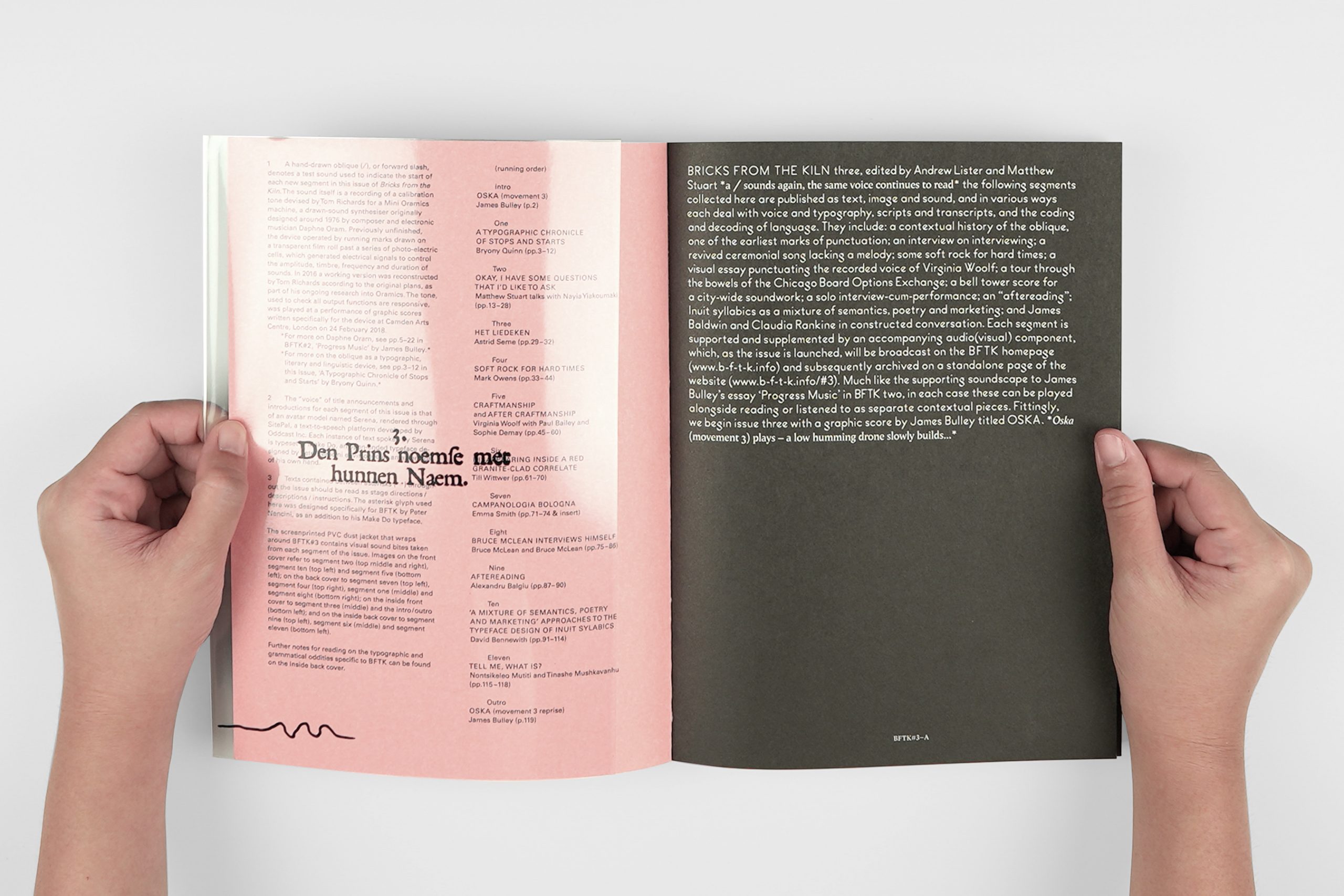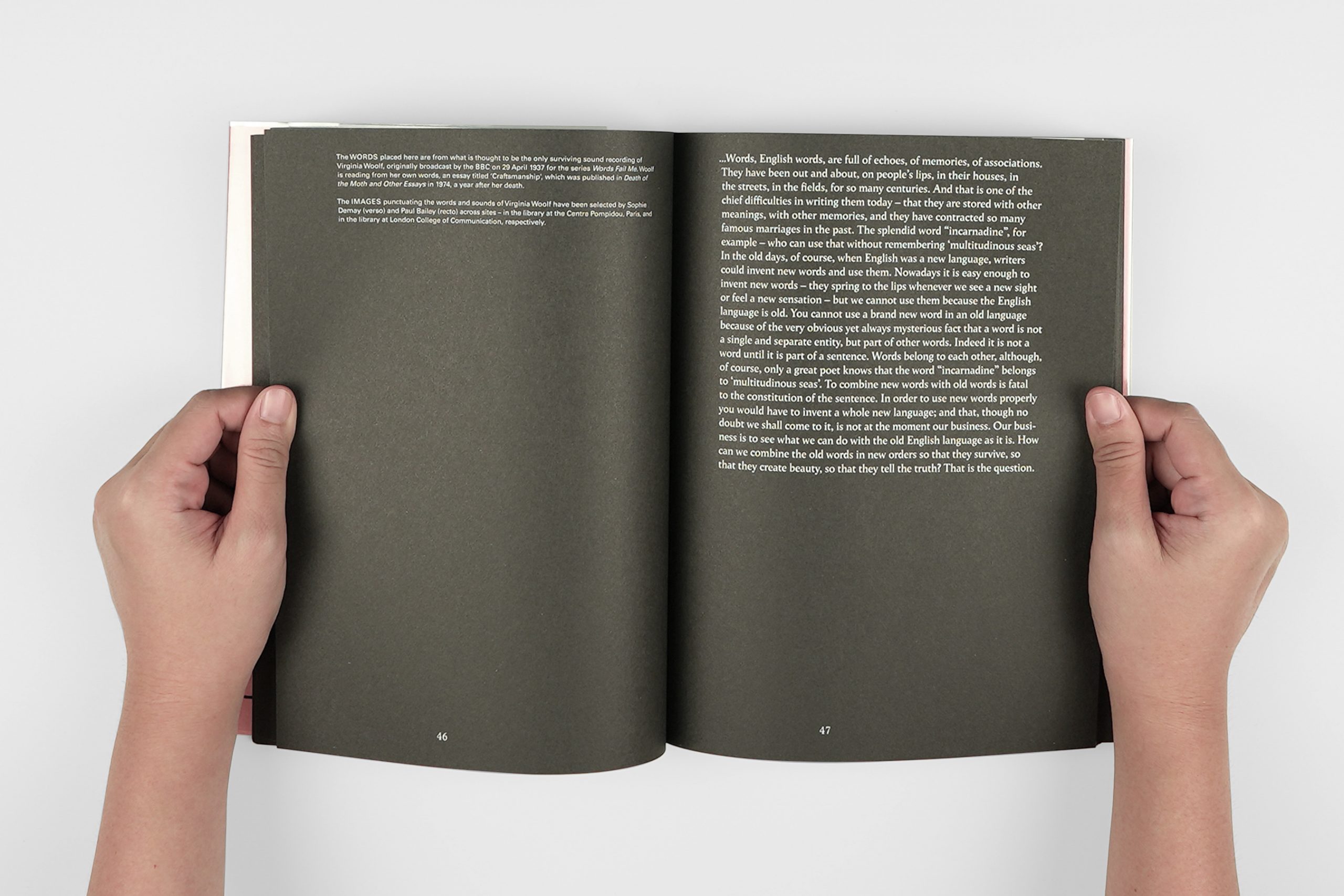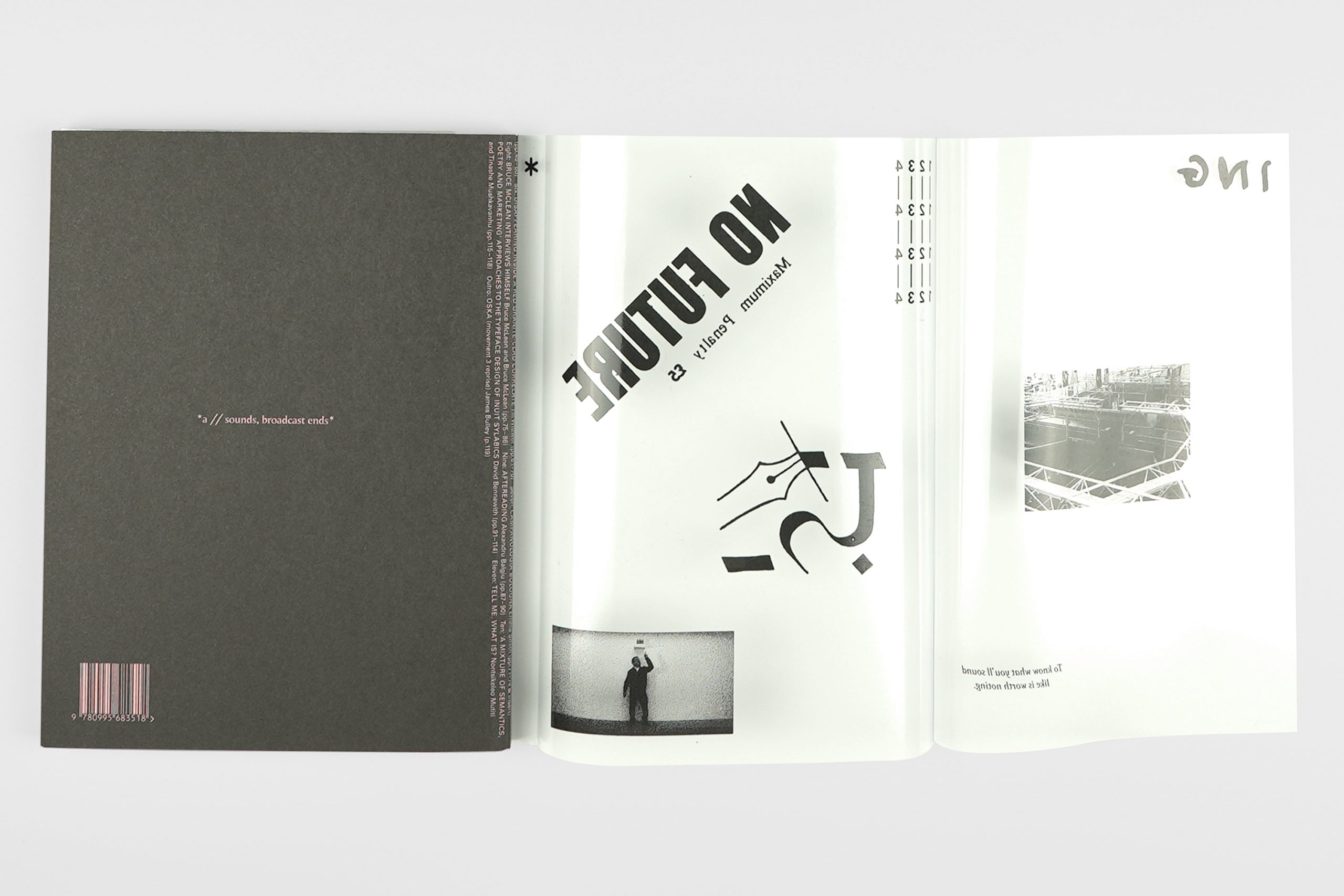Bricks from the Kiln #3
Andrew Lister and Matthew Stuart (Editor)
English
2018
Published by Bricks from the Kiln
(Published as text, image, sound)
London, UK
New York, USA
Designed by Andrew Lister and Matthew Stuart
17 x 22.4 cm, 120 pages (with insert), color, offset, perfect bound, pvc dust jacket
Edition limited to 700 copies
Bricks from the Kiln three, edited by Andrew Lister and Matthew Stuart *a/ sounds again, the same voice continues to read* the following segments collected here are published as text, image and sound, and in various ways each deal with voice and typography, scripts and transcripts and the coding and decoding of language. They include a contextual history of the oblique, one of the earliest marks of punctuation; an interview on interviewing; a revived ceremonial song lacking a melody; some soft rock for hard times; a visual essay punctuating the recorded voice of virginia Woolf; a tour through the bowels of the Chicago Board Options Exchange; a bell tower score for a city-wide soundwork; a solo interview-cum-performance; an “afterreading”; Inuit syllabics as a mixture of semantics, poetry and marketing; and James Baldwin and Claudia Rankine in constructed conversation. Each segment is supported and supplemented by an accompanying audio(visual) component, which, as the issue is launched, will be broadcast on the BFTK homepage (www.b-f-t-k.info)and subsequently archived on a standalone page of the website (www.b-f-t-k.info/#3). Much like the supporting soundscape to James Bulley’s essay ‘Progress Music’ in BFTK two, in each case these can be played along side reading or listened to as separate contextual pieces. Fittingly, we begin issue three with a graphic score by James Bulley titles OSKA. *Oska (movement3) plays–a low humming drone slowly builds…*
About Bricks from the Kiln
“The notion of this content being on or around graphic design relates to the fact that BFTK ultimately collects the kinds of writing that interests and excites us first and foremost as readers, and secondly as designers and typographers. The majority of the writing isn’t necessarily aboutgraphic design or design criticism, but, given that both of our backgrounds are in graphic design, it can be seen through this lens. It’s certainly open-ended though, and deliberately so. Graphic design can sometimes be seen negatively as a kind of parasitic activity, in the way that it attaches itself to other disciplines. However that’s not the case for us. The way in which it can operate as a conduit that both shapes and carries material, and the proximity to other disciplines that it affords, is probably what drew us both to it as as field in the first place. Perhaps “on or around graphic design” isn’t exactly right, but it oddly seems at once more specific and more vague than terms like “visualculture” or “visual communication,” or even “cultural studies,” which are in the right ballpark but don’t sit quite right with us.” — Andrew Lister and Matthew Stuart, interviewed by Paul Bailey in the Gradient
Bricks from the Kiln #3
แอนดริว ลิสเตอร์ และ แมทธิว สจวร์ต (บรรณาธิการ)
2561
จัดทำโดย Bricks from the Kiln
(ตีพิมพ์ในรุปแบบเนื้อหา, ภาพ, เสียง)
ลอนดอน, สหราชอาณาจักร
นิวยอร์ก, สหรัฐอเมริกา
ออกแบบโดย แอนดริว ลิสเตอร์ และ แมทธิว สจวร์ต
17 x 22.4 ซม, 88 หน้า (พร้อมไส้ใน), สี, ออฟเซต, ไสกาว, ปกอ่อนแจ็กเก็ตพลาสติก
พิมพ์จำกัดจำนวน 700 เล่ม
Bricks from the Kiln ฉบับที่ 3 บรรณาธิการโดยแอนดริว ลิสเตอร์ และแมทธิว สจวร์ตในชื่อ *a/ sounds again, the same voice continues to read* ส่วนต่างๆ ที่ถูกคัดเลือกมาในฉบับนี้ถูกตีพิมพ์ในรูปแบบข้อความ ภาพ และเสียง และในวิถีทางต่างๆ ที่แต่ละส่วนเกี่ยวกับเสียงและตัวอักษร สคริปต์และทรานสคริปต์ การเข้าและถอดรหัสของภาษา รวมถึงบริบทประวัติศาสตร์ของตัวเอียง หนึ่งในเครื่องหมายแบ่งวรรคตอนยุคแรกๆ รวมถึงบทสัมภาษณ์เกี่ยวกับการสัมภาษณ์ บทเพลงในพิธีกรรมที่ขาดท่วงทำนองที่ถูกรื้อฟื้นขึ้นมา ดนตรีซอฟต์ร็อกสำหรับช่วงเวลาที่ยากลำบาก ภาพเล่าเรื่องคั่นเสียงที่ถูดอัดไว้ของเวอร์จิเนีย วูล์ฟ ทัวร์ผ่านภายในของตลาดซื้อขายอนุพันธ์ชิคาโก หอระฆังที่สร้างเสียงเป็นฉากหลังให้กับเมือง การสัมภาษณ์ที่กลายเป็นการแสดงสดเดี่ยว ความหลังการอ่าน พยางค์ของชาวเอสกิโม ในฐานะที่เป็นส่วนผสมของทั้งความหมาย บทกวี และการทำตลาด บทสัมภาษณ์โดยเจมส์ บอลด์วิน และคลาวเดีย แรนคีน ในการประกอบสร้างบทสัมภาษณ์ขึ้นมา แต่และส่วนจะมีไฟล์เสียงให้ฟังเพิ่มเติม ซึ่งจะออกอากาศทางโฮมเพจของ (www.b-f-t-k.info) เมื่อนิตยสารเล่มนี้วางจำหน่าย และท้ายที่สุด ไฟล์เสียงจะถูกนำไปฝากให้ฟังบนหน้าเว็บไซต์ www.b-f-t-k.info/#3 เช่นเดียวกับภูมิทัศน์ทางเสียงที่มีส่วนสนับสนุนงานข้อเขียน ‘Progress Music’ ของเจมส์ บุลลีย์ ในนิตยสารฉบับที่สอง ในกรณีทั้งสองกรณีนี้ ผู้อ่านสามารถเล่นไฟล์เสียงขณะอ่านบทความหรือจะฟังไฟล์เสียงแยกเดี่ยวไปในฐานะชิ้นงานที่ช่วยสร้างบริบทให้กับงานก็ได้เช่นกัน จึงเหมาะสมอย่างยิ่ง ที่เราจะเปิดฉบับที่สามของเราด้วยงานกราฟิกดนตรีประกอบของเจมส์ บุลลีย์ที่ชื่อ OSKA Oska (movement3)plays–a low humming drone slowly builds…
เกี่ยวกับ Bricks from the Kiln
“ความคิดของการผลิตเนื้อหาทั้งที่บนเรื่องกราฟิกดีไซน์หรือรอบๆ เรื่องกราฟิกดีไซน์ก็ตาม สัมพันธ์กับความจริงที่ว่าสิ่งพิมพ์เล่มนี้ได้รวมเอางานเขียนต่างๆ ที่ในที่สุดแล้ว เหนือสิ่งอื่นใดทำให้เราตื่นเต้นและสนใจในฐานะนักอ่านในขั้นแรก และที่ตามมาในขั้นที่สองคือในฐานะที่เป็นนักออกแบบและนักออกแบบตัวอักษร ข้อเขียนส่วนใหญ่ไม่ได้เกี่ยวกับ กราฟิกดีไซน์หรือการวิจารณ์งานกราฟิกดีไซน์ แต่เพราะพื้นหลังของเรามาจากกราฟิกดีไซน์ พวกมันจึงถูกมองผ่านเลนส์นี้ แต่เป็นการมองแบบปลายเปิดและตั้งใจคิดมาแล้ว บางครั้งกราฟิกดีไซน์ก็ถูกมองในแง่ลบ เหมือนเป็นปรสิตของงานด้วยความที่ตัวมันเองไปยึดโยงกับศาสตร์อื่นๆ แต่นั่นไม่ใช่ในกรณีของเรา การที่มันสามารถทำงานเป็นเหมือนตัวนำ ทั้งการสร้างรูปทรงและนำพาวัสดุ รวมถึงความใกล้ชิดเชื่อมต่อกับสาขาวิชาอื่นๆ เป็นสิ่งที่ดึงดูดเราเข้าหาศาสตร์การออกแบบนี้ตั้งแต่แรก บางทีคำว่า “เกี่ยวกับหรือเกี่ยวข้องกับกราฟิกดีไซน์” อาจจะไม่ใช่เสียทีเดียว แต่มันก็ดูเป็นคำที่อย่างน้อยก็ทั้งเฉพาะเจาะจงและคลุมเครือในเวลาเดียวกันมากกว่าคำว่า “วัฒนธรรมทางภาพ” หรือ “การสื่อสารผ่านภาพ” หรือกระทั้งคำอย่าง “วัฒนธรรมศึกษา” ซึ่งถึงอยู่ในขอบเขตที่ถูกต้อง แต่ก็ไม่ได้เข้ากับกับพวกเราเสียทีเดียว — แอนดริว ลิสเตอร์ และ แมทธิว สจวร์ต, สัมภาษณ์โดยพอล ไบเลย์ ในนิตยสารออนไลน์ Gradient
ISBN 978‐0‐9956835‐1‐8



